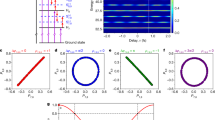Abstract
The generation of ultrashort pulses is a key to exploring the dynamic behaviour of matter on ever-shorter timescales. Recent developments have pushed the duration of laser pulses close to its natural limit—the wave cycle, which lasts somewhat longer than one femtosecond (1 fs = 10-15 s) in the visible spectral range. Time-resolved measurements with these pulses are able to trace dynamics of molecular structure, but fail to capture electronic processes occurring on an attosecond (1 as = 10-18 s) timescale. Here we trace electronic dynamics with a time resolution of ≤ 150 as by using a subfemtosecond soft-X-ray pulse and a few-cycle visible light pulse. Our measurement indicates an attosecond response of the atomic system, a soft-X-ray pulse duration of 650 ± 150 as and an attosecond synchronism of the soft-X-ray pulse with the light field. The demonstrated experimental tools and techniques open the door to attosecond spectroscopy of bound electrons.
This is a preview of subscription content, access via your institution
Access options
Subscribe to this journal
Receive 51 print issues and online access
$199.00 per year
only $3.90 per issue
Buy this article
- Purchase on Springer Link
- Instant access to full article PDF
Prices may be subject to local taxes which are calculated during checkout







Similar content being viewed by others
References
Krausz, F. From femtochemistry to attophysics. Phys. World 14(9), 41–46 (2001).
Steinmeyer, G., Sutter, D. H., Gallmann, L., Matuschek, N. & Keller, U. Frontiers in ultrashort pulse generation: pushing the limits in linear and nonlinear optics. Science 286, 1507–1512 (1999).
Brabec, T. & Krausz, F. Intense few-cycle laser fields: frontiers of nonlinear optics. Rev. Mod. Phys. 72, 545–591 (2000).
Zewail, A. Femtochemistry: atomic-scale dynamics of the chemical bond (adapted from the Nobel Lecture). J. Phys. Chem. A 104, 5660–5694 (2000).
Bhattacharjee, Y. Measuring the immeasurable. Nature 412, 474–476 (2001).
Becker, U. & Shirley, D. A. VUV and Soft X-Ray Photoionization 152 (Plenum, New York, 1996).
L'Huillier, A. & Balcou, P. High-order harmonic generation in rare gases with a 1-ps 1053-nm laser. Phys. Rev. Lett. 70, 774–777 (1993).
Macklin, J. J., Kmetec, J. D. & Gordon, C. L. High-order harmonic generation using intense femtosecond pulses. Phys. Rev. Lett. 70, 766–769 (1993).
Papadogiannis, N. A., Witzel, B., Kalpouzos, C. & Charalambidis, D. Observation of attosecond light localization in higher order harmonic generation. Phys. Rev. Lett. 83, 4289–4292 (1999).
Paul, P. et al. Observation of a train of attosecond pulses from high harmonic generation. Science 292, 1689–1692 (2001).
Ivanov, M., Corkum, P. B., Zuo, T. & Bandrauk, A. Routes to control of intense-field atomic polarizability. Phys. Rev. Lett. 74, 2933–2936 (1995).
Christov, I. P., Murnane, M. M. & Kapteyn, H. C. High-harmonic generation of attosecond pulses in the “single-cycle” regime. Phys. Rev. Lett. 78, 1251–1254 (1997).
Spielmann, Ch. et al. Generation of coherent X-rays in the water window using 5-femtosecond laser pulses. Science 278, 661–664 (1997).
Drescher, M. et al. X-ray pulses approaching the attosecond frontier. Science 291, 1923–1927 (2001). Published online 15 February 2001; 10.1126/science.1058561.
Kitzler, M., Milosevic, N., Scrinzi, A. & Brabec, T. Theory of attosecond streak cameras. Phys. Rev. Lett. (submitted).
Itatani, J. et al. Attosecond streak camera. Phys. Rev. Lett. (submitted).
Milosevic, N., Scrinzi, A. & Brabec, T. Ab initio numerical calculation of attosecond pulse generation. Phys. Rev. Lett. (submitted).
Lewenstein, M., Balcou, Ph., Ivanov, M. Yu., L'Huillier, A. & Corkum, P. B. Theory of high-harmonic generation by low-frequency laser fields. Phys. Rev. A 49, 2117–2132 (1994).
Poppe, A. et al. Few-cycle optical waveform synthesis. Appl. Phys. B 72, 373–376 (2001). Published online 13 December 2000; 10.1007/s003400000526.
Paulus, G. G. et al. Evidence of “absolute-phase” phenomena in photoionization with few cycle laser pulses. Nature 414, 182–184 (2001).
Acknowledgements
We thank M. Uiberacker for assistance with measurements, and Y. Lim and U. Kleineberg for manufacturing the X-ray multilayer mirror. Discussions with M. Ivanov are gratefully acknowledged. This work was supported by the Austrian Science Fund and by the European ATTO network.
Author information
Authors and Affiliations
Corresponding author
Ethics declarations
Competing interests
The authors declare no competing financial interests.
Rights and permissions
About this article
Cite this article
Hentschel, M., Kienberger, R., Spielmann, C. et al. Attosecond metrology. Nature 414, 509–513 (2001). https://doi.org/10.1038/35107000
Received:
Accepted:
Issue Date:
DOI: https://doi.org/10.1038/35107000
This article is cited by
-
Attosecond electron microscopy by free-electron homodyne detection
Nature Photonics (2024)
-
Stable, intense supercontinuum light generation at 1 kHz by electric field assisted femtosecond laser filamentation in air
Light: Science & Applications (2024)
-
Compression of femtosecond-pulse waveforms in spectral intensity filters
Optical Review (2024)
-
Attosecond Physics in a Nutshell
Resonance (2024)
-
Experimental demonstration of attosecond pump–probe spectroscopy with an X-ray free-electron laser
Nature Photonics (2024)
Comments
By submitting a comment you agree to abide by our Terms and Community Guidelines. If you find something abusive or that does not comply with our terms or guidelines please flag it as inappropriate.



